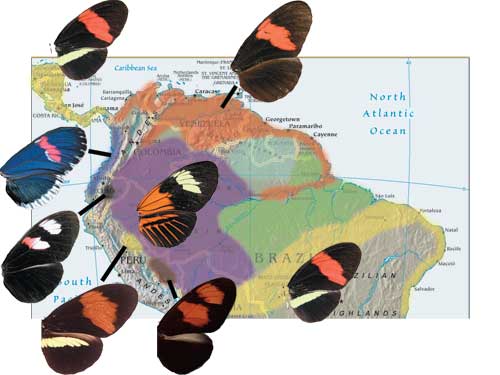Heliconius melpomene
Chris Jiggins and Margarita BeltranIntroduction
Heliconius melpomene is a widespread species well known for its geographic diversity in colour pattern. Across most of its range, H. melpomene is co-mimetic with Heliconius erato, and both species have around 30 named geographic sub-species. H. melpomene is generally less abundant than H. erato, but both are found in open areas. H. melpomene can however be locally common in river edges and along streams.
H. melpomene is an ecological host plant specialist in Central America, where it only feeds on either Passiflora oerstedii or Passiflora menispermifolia. In other parts of the range however it is more of a generalist and can be found feeding on several different Passiflora species. Even in Central America, the larvae will happily develop on most species of Passiflora, so the specialisation is due to the host preferences of the females (Smiley, 1978).
The genetic basis of the geographic variation in colour pattern has been extensively worked out over many years of crossing experiments (Sheppard et al., 1984). Just a few genes of major effect control most of the changes. These loci have recently been shown to be shared across several different Heliconius species (Joron et al., 2006).
References
Joron, M, Papa, R, Beltr?n, M, Chamberlain, N, Mav?rez, J, Baxter, S, Bermingham, E, Humphray, S, Rogers, J, Beasley, H, Barlow, K, ffrench-Constant, R, Mallet, J, McMillan, WO, Jiggins, CD A Conserved Supergene Locus Controls Colour Pattern Diversity in Heliconius Butterflies Plos Biology. Vol. 4, No. 10, e303.
Sheppard PM, Turner JRG, Brown KS, Benson WW, Singer MC. 1985. Genetics and the evolution of muellerian mimicry in Heliconius butterflies. Philosophical Transactions of the Royal Society of London (B) 308: 433-613
Smiley JT. 1978. Plant chemistry and the evolution of host specificity: new evidence from Heliconius and Passiflora. Science 201: 745-7
Title Illustrations

| Scientific Name | Heliconius melpomene amaryllis |
|---|---|
| Specimen Condition | Dead Specimen |
| View | Dorsal |
| Collection | Gerardo Lamas |
| Copyright | © |
About This Page
Chris Jiggins

University of Cambridge
Correspondence regarding this page should be directed to Chris Jiggins at and Margarita Beltran at
Page copyright © 2006 Chris Jiggins and
- First online 18 February 2007
- Content changed 22 February 2007
Citing this page:
Jiggins, Chris and Beltran, Margarita. 2007. Heliconius melpomene . Version 22 February 2007 (under construction). http://tolweb.org/Heliconius_melpomene/72252/2007.02.22 in The Tree of Life Web Project, http://tolweb.org/







 Go to quick links
Go to quick search
Go to navigation for this section of the ToL site
Go to detailed links for the ToL site
Go to quick links
Go to quick search
Go to navigation for this section of the ToL site
Go to detailed links for the ToL site